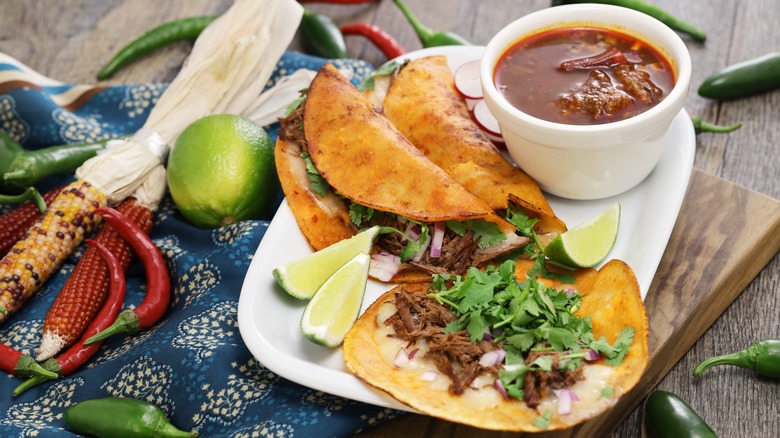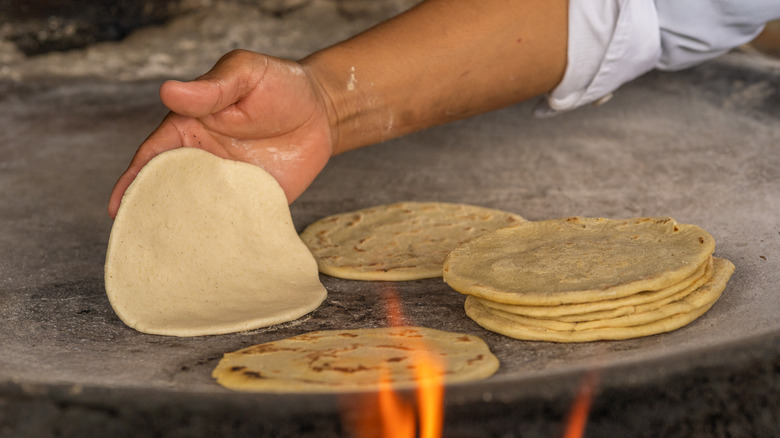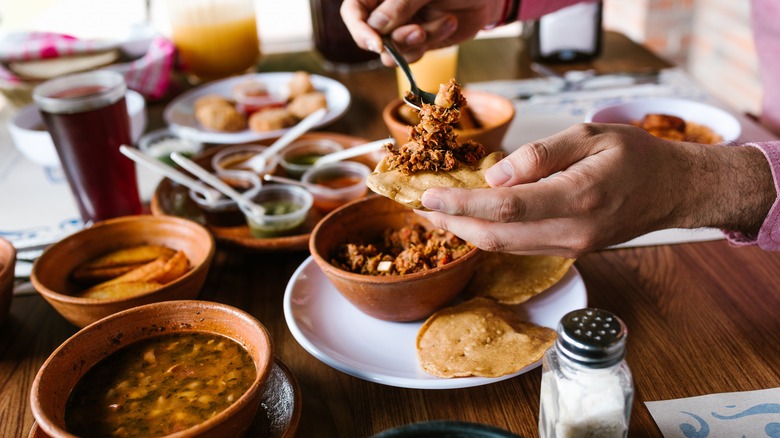Taco Vs. Tostada: What's The Difference?
Combining simple ingredients to create complex flavors is the cornerstone of Mexican cuisine. The fiery chiles, corn-based breads, distinctive spices, and signature ingredients used in traditional Mexican fare have gained global notoriety, so much so that the United Nations Educational, Scientific and Cultural Organization (UNESCO) recognized the cuisine as a contributor to the Intangible Cultural Heritage of Humanity in 2010.
According to El Maguey, ancestral farming methods, traditional cooking practices, and distinctive ingredients set a foundation for today's Mexican food based on corn, beans, and forageable foods native to ancient Mesoamerica. Staple ingredients were built upon by the Aztec culture that utilized salsa, chocolate, and chili peppers to enhance foods. The ancient cuisine was also influenced by Spanish conquistadors who introduced wheat, new livestock, and a variety of ingredients from other parts of the world.
Diverse influences coupled with traditional roots laid the groundwork for craveable Mexican food dishes of today like enchiladas, carne asada, and tamales. Of all the popular Mexican food options, the most beloved and recognizable may be the humble taco. It's the most convenient vehicle for any combination of flavorful fillings, often stealing the spotlight from its lesser-known close relative, the tostada. Both options have a lot to offer, and comparing the two may help you decide which dish to feature on your table.
A brief history of tacos and tostadas
Corn was a main component in ancient Mesoamerican diets, and Uno Casa notes that Aztecs using corn-based flatbreads to hold hot food was likely the first representation of what we now know as a taco. Ancient cultures of central Mexico used the word "tlhaco," which translates to "half" or "in the middle" in English and generally describes how to eat a taco. It hasn't been completely accepted as the origin of the word "taco," as Smithsonian Magazine links the word to a term describing a folded paper used to hold gunpowder during the excavation of 18th Century Mexican silver mines. Over time, tacos evolved with influences from other cultures and came to be the global favorite of today.
According to Food Panda, the Spanish word "tostada" translates to "toasted," describing the cooking method that brought a taco's open-faced cousin to the table. The tostada also boasts age-old origins traced back two centuries to the ancient Mexican city of Monte Albán. When tortillas became less pliable and couldn't fold around the food like a soft taco, the indigenous people began toasting them until they created a flat, crispy tortilla. By frying or toasting the stale tortillas, Amigo Foods notes that the ancient Oaxacans living in the region could extend the life of the flatbread by weeks. Avoiding food waste with this tasty method created the flat alternative to the folded taco that has gained popularity because of a few key differences.
Different but equally delicious
Whether you are stuffing a folded tortilla or piling toppings on a flattened one, tacos and tostadas both offer an ideal way to get more delicious foods into our mouths. You can experiment with vegetarian toppings featuring refried beans, flavorful braised meat options, or a light shrimp ceviche topping. There's a lot of toppings to choose from, but the differences between tacos and tostadas can help narrow it down.
According to All Recipes, a taco is made from a folded corn or flour tortilla that can be served soft or crunchy. Its counterpart, the tostada, is typically made with corn tortillas baked or fried flat to crispy perfection and served open-faced like an edible plate. Because they're folded, flour or corn tacos can hold a variety of fillings, but tostadas can feature more of the same fillings, as toppings can be piled high on their flat surface. However, tostadas can get a bit messy because of the extra fillings and they're not handheld. Presentation is the main difference between the two options, with tostadas offering a more customizable form.
Pre-made crunchy taco and tostada shells are available at grocery stores, but they can be made at home easily. Although there are some handy tricks for homemade taco shells, tostadas require less effort as they are fried flat. Whether you prefer the hand-held ease of a taco or the sky-high toppings on a flat tostada, both options are sure to satisfy.


